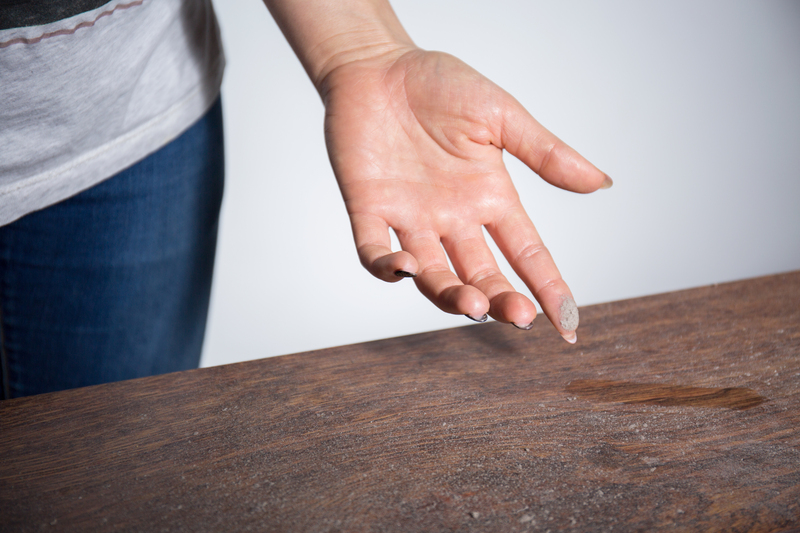Discover Top Methods for Jewelry Cleaning
Posted on 08/09/2025
Discover Top Methods for Jewelry Cleaning
Jewelry is not only a cherished personal accessory but also an investment that reflects style, sentiment, and value. Over time, even the most dazzling pieces can lose their sparkle due to everyday wear, exposure to oils, dirt, and residues from perfumes and lotions. Fortunately, restoring brilliance and maintaining the longevity of your beloved ornaments is simple when you know the right techniques. In this comprehensive guide, you'll discover top methods for jewelry cleaning, ensuring your treasures remain as radiant as the day you acquired them.

Why Jewelry Cleaning Is Essential
Consistent jewelry cleaning serves more than just aesthetic purposes. Keeping your pieces clean:
- Prevents damage by removing corrosive substances
- Preserves luster and brilliance long-term
- Safeguards skin health by eliminating bacteria and allergens
- Protects investment value through routine care
Understanding how to clean jewelry properly helps prevent mishaps and maximizes the lifespan of various metals and gemstones.
Understanding Different Jewelry Materials
Before trying any jewelry cleaning method, it's crucial to identify the type of material you are dealing with:
- Gold: Soft metal, vulnerable to harsh chemicals
- Silver: Prone to tarnishing, needs specific cleaning
- Platinum: Durable but can lose its shine
- Diamonds: Hardest gemstone but easily collects oils
- Pearls: Delicate and organic, require gentle care
- Other gemstones: Each has unique requirements
Different cleaning methods are suitable for each material, so always take heed before proceeding.
Top Home Methods for Cleaning Jewelry
1. Gentle Soap and Water
This classic method is ideal for cleaning most jewelry types safely at home. Here's how to do it:
- Mix a few drops of mild dish soap with warm water in a bowl.
- Soak your jewelry for 15-30 minutes.
- Use a soft-bristled toothbrush to gently scrub any crevices.
- Rinse under running water and pat dry with a lint-free cloth.
Tip: Avoid hot water, which can damage some stones, and never submerge porous gems (like opals or pearls).
2. Baking Soda Paste for Tarnished Silver
Baking soda is a gentle abrasive that can restore the shine to dull silver pieces. Make a thick paste by mixing three parts baking soda with one part water. Gently rub the paste onto your silver jewelry using a soft cloth, rinse thoroughly, and buff dry.
- Never use baking soda on gold, pearls, or soft gemstones as it can scratch these surfaces.
3. Professional Jewelry Cleaning Solutions
Commercial cleaning solutions are formulated to remove grime and restore shine effectively. Many come with easy-to-use trays and brushes.
- Always follow the manufacturer's instructions strictly.
- Check the label to ensure compatibility with your jewelry's materials.
- Rinse your pieces thoroughly after use to avoid chemical residue.
4. Ultrasonic Cleaners
Ultrasonic cleaning devices use high-frequency sound waves to loosen dirt from intricate jewelry settings. While highly effective, they are not suitable for all stones (especially emeralds, opals, and pearls).
Best Use: Solid gold, platinum, diamonds, and sapphires.
Consult your jeweler before using ultrasonic cleaners on valuable or fragile pieces.
DIY Jewelry Cleaning Techniques
1. Vinegar and Baking Soda for Silver
Mix half a cup of white vinegar with two tablespoons of baking soda, soak your silver jewelry for two to three hours, then rinse and dry. This bubbling solution lifts tarnish quickly, making it one of the top at-home methods for cleaning silver.
2. Toothpaste for Quick Shine
- Soft, non-gel, non-whitening toothpaste can restore a quick shine to diamonds and gold.
- Apply with a soft brush and rinse off thoroughly.
- Never use on pearls or porous stones!
3. Ammonia Solution for Diamonds
For sparkling diamonds, a solution of 1 part ammonia to 6 parts water can be used. Dip your jewelry for no more than one minute, brush lightly, then rinse and dry.
Warning: Ammonia is too harsh for gold, silver, or stones like emeralds and pearls.
4. Club Soda Soak
Soaking diamond or gemstone jewelry in club soda overnight can help lift dirt and enhance brilliance without harsh chemicals.
5. Aluminum Foil and Baking Soda Bath for Silver
- Line a bowl with aluminum foil (shiny side up).
- Add hot water, a tablespoon of baking soda, and a pinch of salt.
- Soak the silver jewelry for 10-15 minutes.
- Watch tarnish transfer to the foil--rinse and dry.
This method uses a simple chemical reaction to safely clean intricate silver items.
Special Care: Cleaning Delicate and Vintage Jewelry
Pearls
- Wipe with a soft, damp cloth after every wear.
- Never soak pearls: moisture weakens the string and damages the nacre.
- Avoid harsh soaps, cleaners, or ultrasonic devices.
Opals, Emeralds, and Other Porous Stones
These require extra gentle care. Wipe clean with a soft cloth dampened with tepid water after each use. Avoid soaps, chemicals, and vigorous scrubbing.
Antique or Heirloom Jewelry
Vintage pieces are often fragile and may have previous restorations or non-traditional materials. To avoid unintentional damage, seek professional cleaning and inspection for valuable antiques.
Top Tips for Ongoing Jewelry Care
- Store jewelry separately to avoid scratching.
- Remove pieces before swimming, showering, or exercising.
- Wipe down jewelry after each wear to clear away sweat, makeup, and oils.
- Don't expose jewelry to hairspray, perfume, or household cleaners.
- Schedule regular professional cleanings for valuable pieces.
When to Seek Professional Jewelry Cleaning
While home techniques can help maintain routine sparkle, it's wise to enlist expert services when:
- Handling heavily tarnished, valuable, or sentimental pieces
- Dealing with intricate settings or pieces containing multiple stone types
- Signs of damage, loose settings, or weakened clasps are visible
- Professional ultrasonic or steam cleaning is recommended by the manufacturer
Jewelers use specialized tools and solutions to gently deep-clean and inspect your jewelry, ensuring maximum safety and shine.
Common Jewelry Cleaning Mistakes to Avoid
- Using bleach or acetone-based cleaners which can corrode metals and stones
- Soaking porous stones or pearls in water or cleaning solutions
- Scrubbing too hard, especially with abrasive tools
- Ignoring manufacturer care instructions specific to your pieces
- Not rinsing cleaning solutions properly, leaving residue that dulls the finish
Avoid these missteps to keep your jewelry collection in mint condition.

Frequently Asked Questions
How often should I clean my jewelry?
Regularly worn pieces (like engagement rings or daily earrings) benefit from gentle, weekly cleaning. Statement or occasional pieces can be cleaned monthly or before wear.
Can I use ultrasonic cleaners at home?
Yes, but be cautious. Research your jewelry's materials first and avoid putting fragile or porous stones in ultrasonic baths.
Is professional jewelry cleaning expensive?
Most jewelers offer affordable and even complimentary cleaning for pieces purchased from them. For high-value, antique, or intricate jewelry, professional cleaning is recommended for safety and preservation.
Are there any all-purpose jewelry cleaning methods?
The mild dish soap and water method is the safest universal approach, but always check compatibility with your gemstones.
Conclusion: Shine Bright with Proper Jewelry Cleaning
Caring for your jewelry is an act of preserving both beauty and value. Whether you prefer simple at-home methods for jewelry cleaning or opt for expert assistance, the key is to choose the right approach for your treasures. By following these top jewelry cleaning methods, you can enjoy your cherished pieces in their best possible condition--and make them last for generations.
Discover the joy of sparkling jewelry every day by adopting the right cleaning routine!




